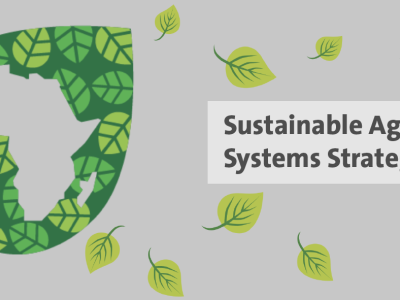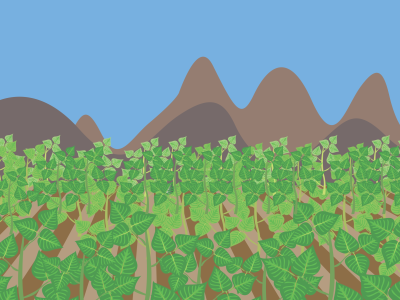
The right evidence to guide integrated investments for food security in Laikipia County, Kenya
Mapping food flows, coupled with ecological, social, and spatial data, helped create a “dashboard” that will strengthen the impact of the next five-year county integrated development plan.
At mid-morning at the market at Kimanjo, in Northern Laikipia County, Kenya, and with no shade structures to speak of, cabbages, tomatoes and bananas that have been hauled here from as far away as 140km over exceedingly rough roads are spoiling. Meanwhile, livestock swat flies with their tails as they await loading into trucks that will take them to butcheries in Nanyuki, a 60km (but 2 hours, thanks to the roads) drive away, and Nairobi (240km and as much as 6 hours away), while the pastoralists who brought them to market sit on the fence and chew dry grass stalks. This bi-monthly market, with its complete lack of basic infrastructure and shade, not to mention refrigeration, is essential to feeding 20,000 local people.
The research team from the World Agroforestry Centre (ICRAF) and EcoAgriculture Partners spoke with the produce and livestock sellers at this market, and others around Laikipia county late last year to map food flows into and out of the county. Data on how much food was being sold in the county, to whom, for consumption where, was not available, but our team knew it was critical if the county government wanted their next County Integrated Development Plan, or CIDP, to improve the food system for vulnerable people in the area. Without understanding the basic movement of food in the county, what we call “food flows,” it would be impossible for the county to take a nutrition-sensitive approach to their planning efforts. Such an approach is critical for Laikipia: chronic and acute malnutrition are everyday problems for a large (but not exactly known, as data for almost everything in the county is poor) portion of the population.
Pastoralists living on the edge
On a good day KES 10 million (€82,000) in livestock can be traded at the Kimanjo market. But, during the months of August-September and January-March, when it’s dry, less than KES 1 million (€8,200) is traded per day. Livestock brokers frequently take advantage of pastoralists, who are desperate to sell animals quickly during this lean period, by offering exceedingly low prices. Pastoralists become especially food insecure during these dry times, because they depend almost entirely on the livestock trade to buy staples like maize and beans.
A seemingly endless drought in the Horn of Africa is magnifying this seasonal variability and contributing to a cascade of crises. The unreliable rain combined with highly degraded land has pushed many pastoral communities in and around Laikipia to desperation, as dwindling water resources threaten their herds, and thus their entire livelihoods. Attracted by more abundant water and relatively healthy grasslands, pastoralists from surrounding counties, where the drought is worse and the climate has long been drier, have led what some in Laikipia call a cattle invasion. The colonial legacy, past violence, and ethnic division in the region complicate the story considerably. Ranchers own large tracts in Laikipia, and in general their management practices have made their land more resilient to the drought. The lure of these sustainably managed islands of green has led to violent clashes between local ranchers and the outsiders, including ethnic Somalis. The recent national elections in Kenya amplified these tensions. Meanwhile, displaced peoples’ camps in Laikipia that were created of necessity during election-related violence in 2007 and 2008 are the loci of some of the worst chronic malnutrition in the county.
Overcoming a failing approach to malnutrition
In the past, the majority of the government’s response to the malnutrition problems in Laikipia, and throughout the country, has largely been “emergency nutrition supplementation” food aid. However, following the new Constitution was passed in 2010, each county in Kenya has greater power and produced a five-year county integrated development plan (CIDP, 2013-2017). Laikipia’s first CIDP repeated this approach: all the nutrition programming was housed in the Health Department focused on supplementation. As one might expect, this approach has not reduced the number of malnourished people in the county. As the county government prepares to issue its second CIDP, it sought a different approach. That’s where our team was able to offer assistance.
Cost-effective integrated solutions emerge from the data
Supported by funding from the Daniel and Nina Carasso Foundation, EcoAgriculture and ICRAF have partnered with the leadership of the Laikipia County government to advance a food systems research-practice-policy initiative to “improve landscape resilience and nutritional security for vulnerable groups in Laikipia County”. The food flows research, coupled with ecological, social, and geo-spatial data gathered by the team and provided by the county, was put into an accessible “dashboard” created by Dr. Tor Vagen at ICRAF, Head of the Geosciences Lab at ICRAF, that presented spatial information on land health alongside other attributes of the landscape. Then, through a series of facilitated workshops using the ICRAF-developed methodology called the Stakeholder Approach to Risk Informed and Evidence Based Decision Making (SHARED), we jointly assessed the evidence to derive a picture of the status of five selected nutritionally vulnerable sites and initiated discussions on landscape and farm level interventions for the different sites, building upon available evidence for linking nutritional security to landscape resilience to improve outcomes for both. Deliberations were intentionally structured to inform preparation of the next CIDP.
For example, in the Kimanjo area, where pasture degradation and water scarcity are especially problematic, investments focused on rehabilitating pasturelands through reseeding, erosion control measures, micro-catchment construction, managed grazing, and contour planting, coupled with community land tenure and support for improved marketing of livestock emerged as particularly high-potential. The team then identified the necessary partners, from government, the private sector and civil society, and next steps and timelines to advance these interventions.
Laikipia County stakeholders see clearly the fundamental importance of a sound natural resource base to cope with and eventually resolve not just malnutrition, but many of the other problems that plague the county. In the final workshop, the 35 participants included county department heads or senior staff representing the agriculture and livestock, environment, water, land, trade and markets, and health and nutrition sectors, as well as strategically invited non-state actors with expertise in related domains including biodiversity and wildlife conservation. Commitment to a cross-sectoral approach to the food system of the county runs deep with these professionals.
Next steps to cement a more integrated approach to food and nutrition security programming by co-investing in agriculture, natural resource management, markets and trade and related sectors will involve examining carefully the spatial data patterns revealed by the dashboard as well as regularly updating and expanding the data. This, in combination with the facilitated process, will enable the targeting of investment priorities in the CIDP to help ensure that financial and human resources are being used most optimally.
Acknowledgement
The authors are grateful to Dr. Tor Vagen and Dr. Stepha McMullin and their team of scientists at ICRAF who have provided leadership for the work on food systems and landscape health in Laikipia County.
About the authors
Louise Buck, Director of Collaborative Management for EcoAgriculture Partners, is also a faculty member in the Department of Natural Resources at Cornell University.
Constance L. Neely is a Senior Advisor for the Integration of Research, Practice and Policy, World Agroforestry Centre (ICRAF).
Louis Wertz is Head of Communications for EcoAgriculture Partners.
Read the full magazine issue





